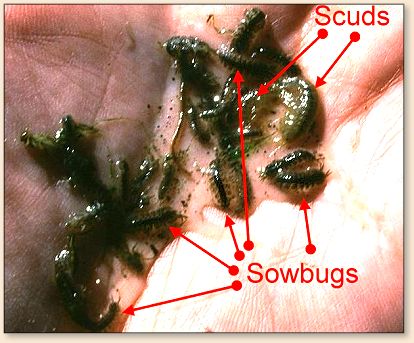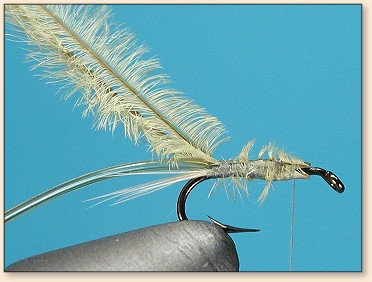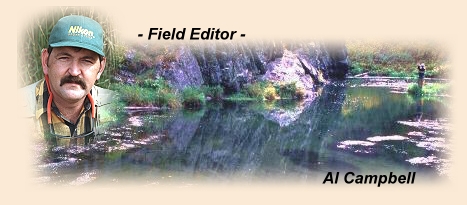|
If you fish the Bighorn River in Montana, even
once, you'll hear about sowbugs. Actually, the
sowbug isn't an insect but rather an isopod or
crustacean similar to a scud which is a member
of the amphipod family. Both are more closely
related to lobsters than insects, but when it
concerns flyfishing, they are as important as
insects in the food chain of many freshwater
fisheries.
Sowbugs are common in most freshwater and more
tolerant of pollution than scuds, so odds are
good that you'll find them in your area, especially
in moving water with a rocky bottom. They don't
tolerate sunlight well, so they are most active
at night (they are members of the same family as
pill bugs, those little armored bugs that crawl
on your driveway at night and roll up into a ball
if disturbed). High water and stream bottom
disturbances are the most common ways sowbugs
are dislodged from the bottom. In any case,
there is enough natural disturbance to keep the
fish looking for sowbugs most of the time.

Since sowbugs and scuds resemble each other, their
fly patterns are often similar and I suspect the
fish don't care if you were trying to imitate a
sowbug or a scud. In fact, it's fairly common for
fish to feed on both when they have the opportunity.
In the Bighorn River, both are common, and both are
important to the fish, and thus the fishermen who
fish for those fish.


I use several patterns that imitate sowbugs. One
of my favorites has been a woven creation that uses
a lace (plastic micro tubing) and ostrich herl body.
I have usually used Larva Lace for the body, but
wished for a type of lace that would stretch to a
thinner size to use on smaller hooks. Until recently,
I didn't have a source for any lace products that
would stretch that thin. Then, my friend Keith Dyer
(KD for the chat room guys) mentioned a new kind of
micro tubing that will stretch to many times its
original length and many times thinner that it started
out as. It's called Liquid Lace, and it's just what
I was looking for.
Call this week's article a combination product review
and fly pattern if you want. For the first time in my
tying career, I am able to tie a woven scud or woven
sowbug on a size 20 hook. Taking pictures of the tying
steps for a fly that small is a lot harder than it is
for a size 12 fly, but I managed to get the job done.
In fact, I managed to catch a couple of fat rainbows
on one of these flies about a week ago. If you want
a small sowbug pattern that catches fish just about
anywhere you find water, give this one a try.
LSB (Lace Sowbug)
List of materials:
Hook - Any standard length wet fly hook - this
one is a Mustad 3399A, size 20.
Tail - Cream to gray soft hackle fibers.
I'm using cream grouse here.
Back - Light olive midge Liquid Lace.
Legs - Light olive ostrich herl, woven using
a Potts body weave with the Liquid Lace.
Back stripe - Dark olive holographic flash.
Thread - 10/0, Light olive/gray color.
Tying steps:
1. Start the thread and tie in the tail keeping
it short.
 2. Tie the Liquid Lace on the top of the hook.
2. Tie the Liquid Lace on the top of the hook.
 3. Tie in two strands of light olive ostrich herl
as shown.
3. Tie in two strands of light olive ostrich herl
as shown.
 4. Fold a single strand of olive holographic flash
in half and tie it down to the top of the hook by
the tips.
4. Fold a single strand of olive holographic flash
in half and tie it down to the top of the hook by
the tips.
 5. When you have the flash tied down, fold it to
the front and tie it down behind the hook eye.
5. When you have the flash tied down, fold it to
the front and tie it down behind the hook eye.
 6. Here is a view from the top of the hook. (Notice
how big the tube of a Tiemco ceramic bobbin looks
compared to that size 20 hook?)
6. Here is a view from the top of the hook. (Notice
how big the tube of a Tiemco ceramic bobbin looks
compared to that size 20 hook?)
 7. Weave the body using the Potts body weave like
the one used in the Sandy Mite. (See woven hackle
flies in the advanced tying series:
www.flyanglersonline.com/flytying/advanced/part3.php).
7. Weave the body using the Potts body weave like
the one used in the Sandy Mite. (See woven hackle
flies in the advanced tying series:
www.flyanglersonline.com/flytying/advanced/part3.php).
 8. Weave all the way to behind the hook eye, then
tie the lace and ostrich off and trim. Leave room
for a nice head. You might have to use a needle to
pick out any herl strands that get caught by the lace.
8. Weave all the way to behind the hook eye, then
tie the lace and ostrich off and trim. Leave room
for a nice head. You might have to use a needle to
pick out any herl strands that get caught by the lace.
 9. Whip finish and cement the head. From the top
your finished fly should look like this (before I
picked the herl out).
9. Whip finish and cement the head. From the top
your finished fly should look like this (before I
picked the herl out).
 10. From the side it should look like this (after
picking the herl out from under the lace).
10. From the side it should look like this (after
picking the herl out from under the lace).

Here you see two LSBs and two LBNs (lace baetis nymph,
pattern coming soon to an FAOL near you) on a penny
with room to spare. If you like using lace or micro
tubing as a body material, and if small flies are
what the doctor ordered for your stream, Liquid lace
is the right product for you. Unfortunately, if you
live in the USA, you'll have to check with the Canadian
distributor for a dealer near you or take advantage
of the currency exchange rate with Canada.
 For more information on this great lace (micro tubing)
catch KD in the chat room or contact Ed Smith at Unique
Fly Fishing Products, phone (250) 376-6641. Or write him at:
For more information on this great lace (micro tubing)
catch KD in the chat room or contact Ed Smith at Unique
Fly Fishing Products, phone (250) 376-6641. Or write him at:
Unique Fly Fishing Products
1244- 12 Street
Kamloops, B.C.
V2B 3C7 Canada
~ AC
|















